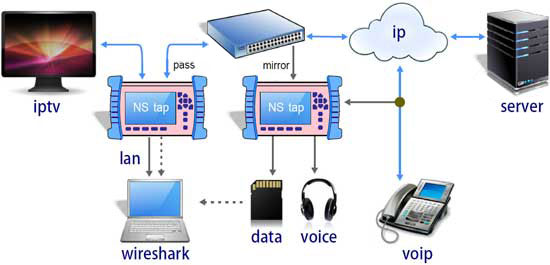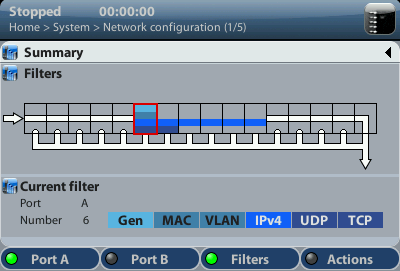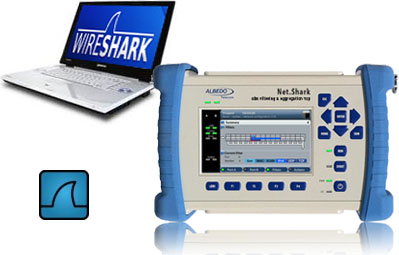Net.Shark: a pocket tap
Net.Shark is the world first Filtering, Capture, Storage, Aggregation Tap developed in a field platform or in a rack. It supports ALL the features of high-end taps in a small, battery operated instrument to provide mobility and storage capacity.
Miami 12.14.22
About Network Taps
A network tap is a hardware device that is used to monitor network traffic. It is typically installed inline with a network connection and allows a network administrator to monitor the traffic passing through the network without disrupting the flow of data. Network taps can be used to monitor traffic for various purposes, such as security, performance analysis, and troubleshooting. They are often used in combination with other network monitoring tools and techniques to provide a comprehensive view of network activity.

Fig 1. Data Centers are one of the most common users of network taps.
Network taps can be used in a variety of different applications and environments, including enterprise networks, data centers, and service provider networks. Some common applications for network taps include:
- Security: Network taps can be used to monitor network traffic for security purposes, such as detecting and preventing intrusions, monitoring for unusual or suspicious activity, and conducting forensic analysis of network traffic.
- Performance analysis: Network taps can be used to monitor network performance, such as tracking the amount and type of traffic on the network, identifying bottlenecks and other performance issues, and analyzing the cause of network slowdowns or outages.
- Troubleshooting: Network taps can be used to diagnose and troubleshoot network problems, such as identifying the source of network errors or connectivity issues, and providing detailed information about network traffic for use in resolving network issues.
Overall, network taps are a valuable tool for network administrators and other IT professionals who need to monitor and manage network traffic.

Fig2. Tap applications.
A variety of different formats
Network taps come in a variety of different formats and designs, depending on their intended use and the type of network they are used on. Some common types of network taps include:
- Standalone taps: Standalone taps are standalone devices that are installed inline with a network connection. They are typically small and compact, and can be easily installed and removed from a network.
- Rack-mounted taps: Rack-mounted taps are designed to be installed in a standard equipment rack, along with other networking equipment. They are typically larger and more feature-rich than standalone taps, and offer more advanced monitoring and management capabilities.
- Handheld taps: Handheld taps are portable, handheld devices that can be used to monitor network traffic in real-time. They are often used by field technicians and other IT professionals who need to quickly and easily monitor network traffic while on-the-go.
Overall, the format and design of a network tap will depend on its intended use and the type of network it is used on. Network taps are typically small and compact, and can be easily installed and removed from a network.

Fig 3. Definition of full-dupex capturing filters at MAC, VLAN, IP, UDP and TCP layer.
ALBEDO Net.Shark
Net.Shark is a portable, battery-powered faucet capable of filtering, capturing, storing, and aggregating traffic in real time. Net.Shark is equipped with a unique Zero Delay technology based on FPGA analysis that guarantees that each packet that passes through the line is monitored in real time and if it meets the filtering criteria it is captured and aggregated on an Ethernet line for later processing. analysis. Net.Shark overcomes most of the limitations of laptops that cannot capture Full Duplex traffic in real time, let alone analyze without interfering with traffic flows. Captured packets can be saved to disk in PCAP format or copied to a LAN in real time for further analysis.


